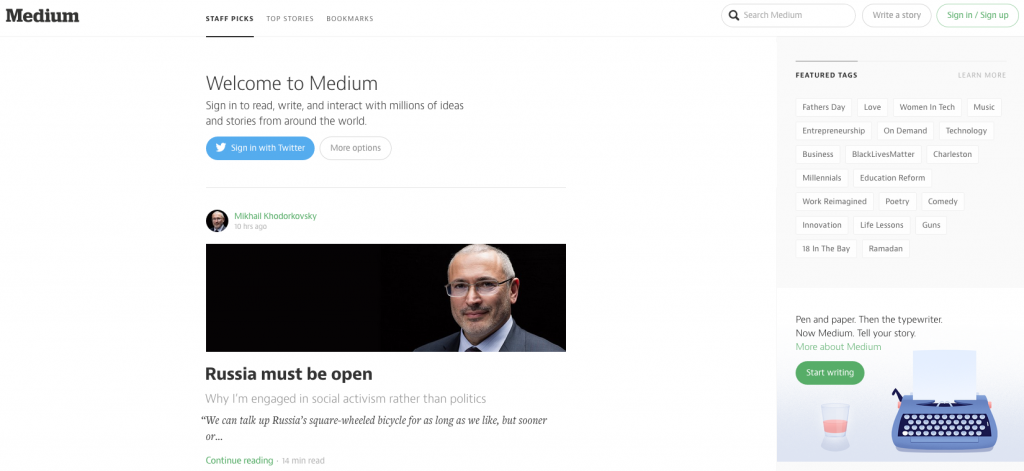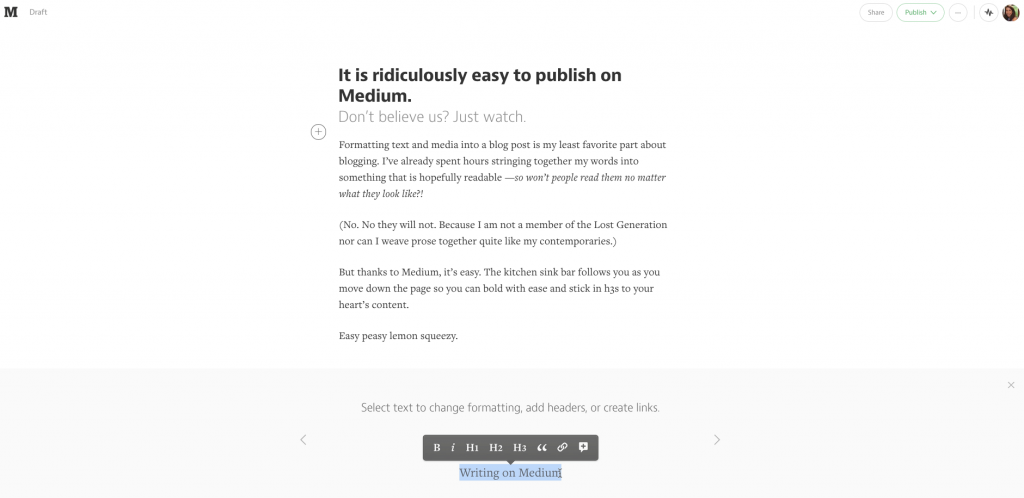Medium: You’ve probably heard of it. And you probably don’t know much more than its name. What am I supposed to do with it? (Publish all of your juicy content.) Is it a social network? (No.) Can businesses join? (Absolutely—and there’s a great chance yours should!)
At its simplest, Medium is a content publishing platform. At its most complicated, it’s, well—it’s not complicated at all, actually. And that is what makes it so great.
Medium prides itself on this streamlined simplicity with its no-frills interface and publishing capabilities. Just look at its homepage, and you can appreciate how bare it is, a stark contrast to other publishing sites with 3-deck headlines and a mess of copy.
Even setting up a post on the backend is a breeze; formatting, every blogger’s nightmare, is a cinch. That means when you’re ready for the world to read your words, you don’t have to go through a bunch of hoops to make your story pop. Once you hit the publish button, your content look clean, and above all, readable, against Medium’s crisp background.
Like all things Internet, what fits one business’ goals won’t necessarily fit another’s (for example, Snapchat works well for Taco Bell but probably doesn’t work as well for a B2B). Similarly, not every business will reap rewards from Medium. But in some cases, it can be just what your blog needs to take it from ho-hum to hot damn! Read about five reasons why Medium just might be your Cinderella fit.
Your business isn’t a business based on blogging, and your blog doesn’t (yet) drive the majority of your leads.
You know by now that having a blog is wonderful for many reasons: Fresh content gives bots reasons to crawl your sites; you have more fodder to share on social; and hosting a blog is a great way to establish yourself as an authority in your industry.
But if a blog isn’t the main pusher of sales, Medium is something to consider.
One of the central arguments against using Medium is that it negates the benefits of a domain-hosted blog. You can’t build an email list inside the Medium platform and any SEO juice your Medium posts drum up would benefit Medium, not your blog.
But if you’re already posting on your domain-hosted blog and not seeing a lot of kickback (perhaps because you are still in the beginning of your content marketing efforts), Medium can give you a bigger audience without taking any piece of the pie from the domain-hosted blog. If your blog isn’t central to your business strategy and you aren’t building many links to your site via your blog posts, switching to Medium probably won’t be harmful to your content marketing efforts.
You blog sporadically and without a rigid calendar to follow.
Because of Medium’s algorithm, the date a post is published holds very little weight; rather than following the traditional blogging practice of showing the most recent post first, the algorithm shows the best posts in order. This works in your favor because gaps in posting won’t be as obvious. Of course, we recommend a business have a blogging strategy before pushing out streams of content; however, if resources are sparse and blogging isn’t a central focus, Medium can help.
Not a lot of businesses are on the platform—yet.
This could go either way, but there’s something to be said for joining a new frontier. Just think about the success the first businesses on Facebook enjoyed: less competition for their content to hit news feeds. The same could be said for Medium. There isn’t quite as much noise for visitors to weed through. Some are even using it for user-generated content purposes, such as ESPN and its FC World Cup series. The partnership encouraged fans to share their perspectives on the tournament, and ESPN posted the best ones on espnfc.com.
You still get analytics from Medium.
Posting on Medium doesn’t mean you would lose juicy intel telling you how your content performs. You can still see the number of views, reads and recommendations your stories have. Reads are the number of people who made it to the end of your story. Recommendations are similar to a “Like” on Facebook or a +1 on Google Plus—validation that other people find value in your content.
And then there is the read ratio, an especially juicy piece of info. The read ratio is the difference between reads and views. Medium wants to reward engaging content by showing it to other people. One way to do this is to take the read ratio into consideration. A good read ratio means of the number of people who viewed your story, a high number will have read the story. (Obviously, this is the Holy Grail and what every writer on Medium aims for.) On the flipside, if you have a flashy headline but no meaty content, your ratio won’t be as high because fewer people will have read it. That is not the content Medium wants to show others.
You can include a link back to your website in a Medium post.
Simple to note, but important: You can add links to your Medium post back to your site. This means that your content doesn’t have to live on Medium with no hope of drawing visitors back to the hub that is your website. While these links will not benefit you from an SEO standpoint, they can still increase quality traffic to your site.
Medium can be a powerful tool to add to your content marketing arsenal. It’s an easy-to-use platform that gets your content out there quickly, and more importantly, into the hands of an interested audience.


